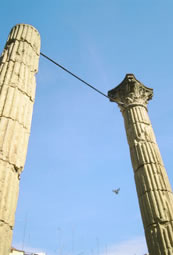
December
Els Pastorets (December and January)The Nativity has been staged during the last eight centuries thanks to ‘Els Pastorets’ or ‘The Little Shepherds’ performance which has been dramatized by different amateur groups. These performances come from medieval dramas in Latin which were represented in the liturgical professions from Christmas Eve until the Epiphany. In 13rd and 14th centuries they were already made in Catalan and some apocryphal evangelists’ texts (not recognized by the Church), lessons of catechism as well as elements of the popular imagination such as the ‘calderes’ of Pere Botero and the Dance of Devils were incorporated.
The most ancient Nativity performance keeps date back to 1880 and it was represented in Castilian, and the most ancient ones in Catalan language date back from 1887. The performance which was written by Frederic Soler Pitarra in 1891 wrote are also very important. At any rate, the best known and represented one at present is that created by Josep Maria Folch i Torres in 1916 with the title of ‘Els Pastorets’ or ‘L’Adveniment de l’Infant Jesus’.
This tradition is very rooted on the Tarragonese region and, consequently, in the Costa Daurada. There are many villages which work hardly in order to perform the best play during Christmas.
The Living Crib in La Pobla de Montornès (December and January)
The Living Crib is staged around the hermitage of Montornès, placed in a small hill nearby to The Pobla de Montornès, which is situated 15 km away from Tarragona. From the beginning of the performance, the actors are divided into different groups which must follow an outer itinerary until the Hermitage of Montornès, whose duration is around 45 minutes approximatly. The itinerary is guided by a person who is called "old shepherd". He responds any question related on the different scenes of the Living Crib. It is a traditional Christmas performance which is transformed by adding novelties every year.
If on the arrival to the hermitage a shift has already started, it is possible to wait in the facilities area where there is a shop of souvenirs and the bar service. These performances can be suspended in case of whether inconveniences.
The Man of the Noses (31st December)
On the 31st December the Man of the Noses visits several villages and towns of the Tarragonese counties. The Man of the Noses is a mythical, imaginary, non real and sometimes a sinister character that turns up the last day of the year. Children believe that he is "a man who has as many noses as days has the year" and they expect to see a terrible being with 365 noses walking along the street of their village. This character symbolizes the year and ithalic god Janus, which was represented with two faces: one with child appearance and the other one with an elder look, one that looks ahead and the other one that do it back, and he always has two keys, that of the Heaven and that of the Hell.
Approfondimenti
|
FORUM
